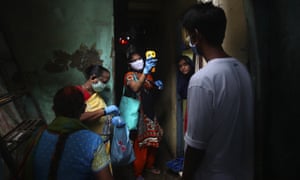The place that seemed like the last in the world capable of containing the virus – Dharavi slum in Mumbai – has been hailed as a success story by the WHO director general, Tedros Adhanom Ghebreyesus, writes Amrit Dhillon in New Delhi.
Speaking recently about countries that had done well in the pandemic, Dr Ghebreyesus included Dharavi as an example of how, even where the outbreak was intense, it could be brought under control.
“Even in Dharavi, a densely packed area in Mumbai, a strong focus on community engagement and the basics of testing, tracing, isolating and treating all those that are sick is key to breaking the chains of transmission and suppressing the virus,” he said.
The largest slum in Asia at one point looked as though it might become a charnel house. A million people live in a 2.5-kilometre area. Its population density offers perfect conditions for the virus to rip through. Infections rose inexorably.
But last week, the slum started reporting a single-digit rise in Covid-19 cases, while in the rest of Mumbai, the worst affected city in India, the spread showed no sign of ebbing. On Sunday, only five positive cases were recorded.

Experts say a combination of measures flattened the curve. A strict lockdown was enforced. Although this caused great hardship and loss of income, residents cooperated. They voluntarily closed tiny shops or tobacco booths where people might have congregated.
The alleys and lanes were constantly sanitised. Health workers, doctors and nurses were present 24/7 to screen and test. Masks and sanitisers were freely provided. Since home quarantine was impossible in such congested living conditions, nearby hostels, schools and stadiums were turned into quarantine centres.
Fever clinics were set up so that residents could be screened and cases detected early, before they could infect others, a measure that proved faster than testing. Community kitchens provided free meals as no one was able to go out and earn a living.
Dharavi’s total number of cases stands at around 2,400. The city authorities believe it can be a model for Indian cities, including the capital New Delhi, struggling to stop new infections.